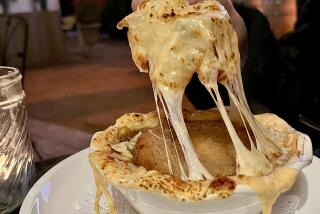Duck--It’s Another Holiday Bird
- Share via
Late autumn is duck season. From now until Christmas this delicious meat will be readily available fresh, at comparatively low prices.
But will anybody buy it? No--not so you’d notice. The average American currently eats about half a pound of duck a year.
This is undoubtedly because ducks have stubbornly refused to enter the modern age. Producers of other meats have made the necessary compromises with our health and speed-conscious age: Pork has slimmed down, chickens and turkeys are sold in ever-more-convenient parts. But nearly all American ducks are the super-fatty Pekin (Long Island) type--leaner breeds such as mulard and muscovy are more often written about than seen. And when you buy duck, you have to buy a whole one; duck is scarcely ever sold as breasts or legs.
Parts are almost never called for, either. Entire birds still firmly rule the recipe roost, whether they’re roasted or braised, served with orange sauce, sauerkraut or olives. Similarly, all you hear about fat-reduction is various schemes for pre-cooking that melt some of it off. Yet duck is as easy to cut apart as chicken, and darn near all the fat is in the skin, which is absurdly easy to peel away.
If you divide it into its logical parts, a standard, roughly five-pound duck will yield two to three servings of lean, boneless duck breast, as well as a pair of legs to grill, curry or combine with the body meat to make chili, stew or a loaf of pate. That duck will also provide the base of a very fine soup.
And, of course, a great humongous lot of duck fat. Needless to say, you can throw it away, but this is wasteful and expensive. Far better to cut it into small pieces, add about half a cup of cold water, then cook very slowly in a heavy pan. Eventually, all the water will simmer away and you will have a panful of golden liquid with dark brown cracklings floating in it.
Drain the cracklings, salt lightly, and serve as a snack or as a garnish for noodles or mashed potatoes. Chill the clear fat--it keeps for months--and use, sparingly, as a butter substitute. It’s great for vegetables and in any sauce or stew that also calls for chicken broth. And it’s delicious in yeast bread or highly spiced sweets such as gingerbread.
For the best duck soup, remove any usable meat, then roast the bones in a hot oven until they are well browned. Rinse out the roasting pan with hot water and add that to the stock pot along with the usual broth-making ingredients.
The breast is the star component, as versatile as beef fillet, just as quick to cook and even more special to serve. The following recipe adds wild mushrooms, enhancing flavor and stretching the servings a bit.
The Stroganov treatment is usually described as a 19th-Century invention, created by the chef of the eponymous Russian count. In fact, meat with mushrooms and sour cream is to Eastern Europe as fried chicken is to the Southern United States, not so much an invention as a long-standing institution.
It was almost an institution here too, in the 1950s and ‘60s. First exotic, a dish for gourmets, “Stroganoff” became a staple--grande luxe on the cheap and easy. Hamburgers Stroganoff, for instance, were a regular item in my early married days.
Then all was silence. Done to death and somewhat passe, Stroganoff disappeared. Too bad--it’s terrific, especially when applied to duck breast. Quick too.
This recipe contains three rather difficult ingredients. The more of them you can obtain, the better it will be, but you can make something very tasty with any or all of the following substitutions.
Duck breast is very dense, rich and tender; the closest readily available substitute is the Stroganov original: well-marbled beef, strip steak or tenderloin. Every wild mushroom has its own distinct flavor and texture, so there’s a lot of latitude in that department. Cooks who do not gather their own will do very well with a mixture of half cultivated white mushrooms and half shiitakes. For genuine, un-messed-with cream there is no substitute. If all you can find is the ultra-pasteurized kind, use a full cup of sour cream (check the label to be sure it doesn’t contain vegetable gum) and add about two tablespoons of milk.
DUCK BREAST AND WILD-MUSHROOM STROGANOV
Skinned, boned breast from 4 1/2-to 5-pound duck, about 1/2 pound
3/4 pound meaty wild mushrooms such as porcini or matsutake
1 medium onion, diced small, about 1 cup
2 tablespoons butter or duck fat
1 tablespoon flour, mixed with dash dry mustard
1/2 cup whipping cream, not ultra-pasteurized
1/2 cup sour cream
Salt
3 tablespoons finely minced parsley
Cooked broad egg noodles, rice or mashed potatoes
Slice meat diagonally into thin strips and set aside. As closely as sizes permit, slice mushrooms into pieces same shape as meat but slightly larger.
Cook onion in butter in wide skillet over low heat until thoroughly tender but not browned. Add mushrooms, raise heat to medium-high and cook, stirring constantly, until mushrooms and onion are well browned and there is no liquid in pan.
Remove and reserve mushroom mixture. Add meat strips to pan, scattering in single layer. Raise heat to high and stir-fry about 2 minutes, just long enough to firm meat.
Reduce heat to medium low, sprinkle on flour mixture and cook, stirring, for another minute or so. Stir in mushroom mixture, then cream and sour cream. Continue to cook, stirring, until sauce is smooth and thick, 2 or 3 minutes more.
Season to taste with salt. Transfer to warmed serving dish, sprinkle on parsley and serve at once, accompanied by broad egg noodles, rice, or mashed potatoes. Makes about 4 servings.
More to Read
Eat your way across L.A.
Get our weekly Tasting Notes newsletter for reviews, news and more.
You may occasionally receive promotional content from the Los Angeles Times.










